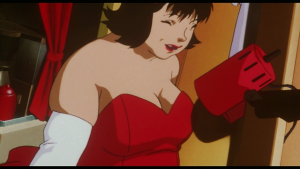Perfect Blue and Social Acting
June 7, 2015 · 0 comments
By Raz Greenberg
 When Perfect Blue debuted in English-speaking territories in 1999, it was hyped for the “adult” elements that most people associated with anime (and, I suspect, also appealed to at least some part of the anime fandom at the time), at least superficially. It was a thriller about a girl stalked by a psycho, with graphic violence and nudity. Kon’s later directorial efforts – Millennium Actress, Tokyo Godfathers, Paranoia Agent and Paprika went beyond this perception of anime, to shape a tragically short career that made him one of the most eclectic of anime directors. But all these films had one common theme: they were all about playing different social roles from those that their protagonists expected. Perfect Blue remains a prime example of this theme.
When Perfect Blue debuted in English-speaking territories in 1999, it was hyped for the “adult” elements that most people associated with anime (and, I suspect, also appealed to at least some part of the anime fandom at the time), at least superficially. It was a thriller about a girl stalked by a psycho, with graphic violence and nudity. Kon’s later directorial efforts – Millennium Actress, Tokyo Godfathers, Paranoia Agent and Paprika went beyond this perception of anime, to shape a tragically short career that made him one of the most eclectic of anime directors. But all these films had one common theme: they were all about playing different social roles from those that their protagonists expected. Perfect Blue remains a prime example of this theme.
Beware: spoilers for Perfect Blue follow
In Perfect Blue and his subsequent films, Kon emphasized theatrical elements in the life of his protagonists by corresponding with two key social concepts in Japan – honne and tatemae. These concepts represent the tension between an individual’s true feelings (honne) and public behaviour (tatemae) – literally, the social role the individual plays. In Perfect Blue, Kon tells a story of two characters lost within their their social role. The most obvious is the protagonist, Mima: she begins the film as a young pop-star, whose fans expect her to maintain a clean and innocent image. When she gets tired of playing this role, and wishes to develop her career further, she becomes an actress in an adult television show – and discovers that here, too, she has a social role to play off-screen. The social environment that surrounds her now expects her to go all the way with her new “bad girl” image. Again, Mima discovers that she must play a part that isn’t her true self.
 But there is another character trapped in a social role in the film, which in many ways is the film’s true victim – Mima’s agent Rumi. Throughout the film, Rumi is supposedly forcing Mima’s tatemae on her – that of her old role as a pop-star, since Rumi sees Mima’s move to acting as a bad decision, an attempt to avoid the true social role that Mima is meant to play. But at the film’s climax, we learn that Rumi, a former pop-star herself, is still mired deep within this role many years after she retires, and sees Mima as a way to relive her glory days, when she fulfilled this role to the satisfaction of society. Mima’s victory in the final struggle with Rumi is not only the removal of the real threat that Rumi posed to her life but also her success in channelling her true honne personality into the tatemae of society’s expectations.
But there is another character trapped in a social role in the film, which in many ways is the film’s true victim – Mima’s agent Rumi. Throughout the film, Rumi is supposedly forcing Mima’s tatemae on her – that of her old role as a pop-star, since Rumi sees Mima’s move to acting as a bad decision, an attempt to avoid the true social role that Mima is meant to play. But at the film’s climax, we learn that Rumi, a former pop-star herself, is still mired deep within this role many years after she retires, and sees Mima as a way to relive her glory days, when she fulfilled this role to the satisfaction of society. Mima’s victory in the final struggle with Rumi is not only the removal of the real threat that Rumi posed to her life but also her success in channelling her true honne personality into the tatemae of society’s expectations.
The protagonists of Kon’s subsequent films – the celebruty of Millennium Actress, the homeless people of Tokyo Godfathers and even the dreamers of Paprika – have also faced a struggle between the roles that society expected them to play and their true feelings, and for the most part, not unlike Mima, managed to find the right balance at the end. It is not only the struggle, but also the optimistic note on which it ends, that typifies Kon’s works – and that makes his debut film an anime classic to this day.
Raz Greenberg recently received his PhD on animation as a text from the Hebrew University.
anime, customs, honne, Japan, Perfect Blue, presentation of self, Satoshi Kon, social acting, tatemae
Impressions of Perfect Blue – All the Anime – ANIME79
March 22, 2019 2:49 am
[…] can see Perfect Blue as horror or post-horror, as reflecting on deep Japanese values or on transient J-pop. You can link Mima to the disintegrating heroines of Polanski’s Repulsion […]